Schooner Yacht Coronet
We would like to thank Richard Konkolski who has given us permission to reproduce the Coronet images below from his "Seven Seas" website. The black and white Coronet photos were taken prior to the Kingdom's involvment with the ship. The John Mecray prints of the Coronet, formerly exhibited here but currently not pictured on this site, may be viewed and purchased through www.mecray.com If any readers wish to contribute photos of the ship to the site, they would be appreciated.
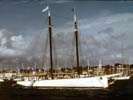 |
Coronet at berth, 1994 in Newport, R.I. |
The sailing yacht Coronet looms so large over the Kingdom's story that it is difficult to know where to start. It has it's own "mythology" and, by rights, should probably have its own separate web site. Someone else, no doubt will eventually make that happen. A volume by Timothy Murray, son of Frank Sandford's biographer, Frank S. Murray, has recently been published entitled "Coronet, Conquering and to Conquer", a highly detailed account of the boat's beginnings, voyages, owners, and races and its present status as a restoration/ learning tool for the International Yacht Restoration School, in Newport R.I.
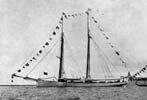 |
Coronet in Yokohama for the 1897 solar eclipse |
On March 3, 1905 the Kingdom purchased the yacht Coronet. The boat was acquired with the intent for use in global mission work. The Kingdom had previously owned smaller, inshore vessels and utilized them for evangelization campaigns along the coast of Maine and on the many islands that dot her bays. Mr. Sandford had for some time been desirous of a trans-oceanic sailing vessel due to the Kingdom's growing commitments abroad coupled with his deep love for the wind in the canvas. Along with the Coronet, a larger ship was acquired, and re-christened as the Kingdom. Whereas the Coronet could accommodate only about 30 souls comfortably, the Kingdom, a barkentine, could easily handle 60 or more. Originally a freighter but refitted to accommodate passengers as well, the Kingdom would be responsible for carrying the supplies, staples, and support crew for the various missionary efforts. To draw a parallel with the open road of today, the Coronet could be likened to a Corvette, while the Kingdom would have been closer to an over the road long haul truck or bus.
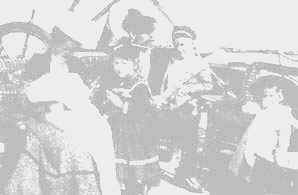 |
Rev Frank Sandford and family aboard Wanderer, about 1903-4 |
The Coronet had already been around the world twice when Mr. Sandford bought her for the tidy sum of $10,000. In his Sublimity of Faith, Frank Murray refers to the transaction as a real "deal", although the prayer warriors of Shiloh immediately began a 40 night and day prayer battle for the necessary funds. She was taken to the Mediterranean and the Holy Land on several occasions between 1905 and 1907, whereupon she began her "Remove the Covering" circumnavigation, the purpose of which was to enable Mr. Sandford with "The Thirty" to pray for each and every nation as they sailed past.
 |
This is one of a pair of stained glass windows that once graced the entrance to Coronet’s main saloon at the foot of her grand marble staircase. Removed from the ship in the mid 1940s, they languished in storage for over 50 years. Early in 1999, Newport, R.I. stained glass craftsman Tom Malone restored both windows to their original splendor. During the summer of 1999, they were on exhibit, along with many other Coronet artifacts, at the Newport Art Museum. The photo at left and text above is from the IYRS website. Visit them in Newport, R.I. or in cyberspace at IYRS |
That being completed in 1909, the Coronet returned to Maine, on or about August 17. Some of the heroic stories of that mission trip are detailed in The Golden Light on the Two Americas by Frank W. Sandford, and certain other stories are also referred to in Sandford's Revelation sermon printed elsewhere on this site.
In October, Mr. Sandford together with his family, left on the Kingdom for the near east in order to close the Alexandria and Jerusalem missions. Mrs. Almon Whitaker, wife of one of the ministers, together with her four children
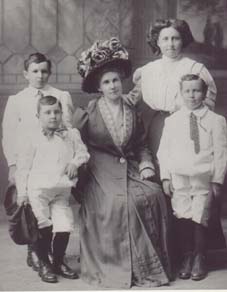 |
Mrs. Almon Whitaker, and children, from a photograph donated to the website by the Whitaker family |
had made the decision to leave the Jerusalem mission on their own, and by the time of Mr. Sandford's arrival in 1909 had retired to the American consulate in Jaffa, where they had sought passage home. Mr. Sandford, finding them there, convinced her to return to the states with the rest of the group. On May 8, 1910 the Kingdom returned to Maine. Mrs. Whitaker, however, was kept aboard nearly a month against her will and not allowed to disembark. Mr. Whitaker, who had sailed on board the Coronet on its circumnavigation, and whom Mrs. Whitaker had not seen in about 3 years had remained in Maine caring for Shiloh during this last voyage. Both Mr. Whitaker and Mr. Sandford attempted to persuade Mrs. Whitaker to return to Shiloh with the rest of her family, but she steadfastly refused to do so. She would gladly leave with her husband and family as long as the destination was anywhere but Shiloh or other Kingdom property. For days they sailed Casco Bay and occasionally disembarked on various and sundry islands with no change of heart on anyone's part.
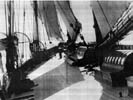 |
Coronet's foredeck, under sail |
On May 26 she wrote a letter to Almon's brother, Rufus, portions of which are reprinted below from Shirley Nelson's book Fair, Clear & Terrible :
"... The children and I are still here on this ship and they simply won't let us land. This is what I was afraid of when I was in Palestine. One of the reasons why I didn't want to come this way and chose to come on a steamer was because I felt sure they would never let me get ashore but get Al on board and put out to sea or something of this kind and they would never let me land until children and I were "straightened out", as they call it, and back into the movement again.
Oh you should have heard the promises Mr. Sandford made if I only would come with him instead of the other way[steamer]; he said he had taken me to Palestine, now he wanted to land me again in my own country...; and when I got here I was free to do as I pleased, take my train immediately and go home if I wanted to [to Aroostook County, Me.].
[She only wished for her husband to be able to] ...live with us now and make a home for his family and provide for us. I would be glad and willing to work hard and live anywhere if he would only come but I cannot live any longer as I have the past thirteen years."
and continuing on from Fair Clear & Terrible,
"Florence had been to Sandford three times, she said, asking to be taken ashore, and "he utterly refuses to allow me to go, until, as he says, I am adjusted to my husband: then, whatever God wants my husband to do, he is willing."
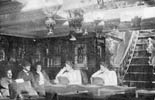 |
Coronet saloon, with marble staircase in background |
On June 6, 1910 the Sheriff, with a writ from the court, removed Mrs. Whitaker and children from the Kingdom, after 29 days of detention. Her brother-in-law, Rufus, had contacted Mr. Nathan Harriman, who had subsequently retained legal counsel for them. She immediately proceeded to Boston where her family received her, and where she was able to tell her story to the Boston Globe. Suit was filed in her behalf against Sandford for $5,000 for forcible detention.
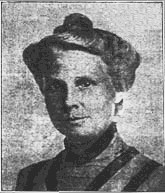 |
Mrs. Almon Whitaker, from a photo in the Lewiston Journal, circa 1912 |
The Kingdom's prophet, made aware of the brewing storm back home, instead put back to sea, desirous to open a mission in West Africa. A small diversionary cruise to the Canadian Maritimes was completed before leaving for the dark continent. In so doing, while off Nova Scotia, the Kingdom ran aground, which necessitated repair. Because money was always in such short supply and labor relatively abundant, a telegraph message was sent to Shiloh for manpower. A large contingent came overland to the site of the accident, built a coffer dam around the damaged area, pumped out the water, executed the necessary temporary repairs, and made for Halifax, Nova Scotia where the Kingdom was hauled and properly attended.
Delayed by repairs into November, the Kingdom eventually caught up with Coronet, which by then had made Chesapeake Bay. Later on in December, two of the crew, Alexander Sinclair and Pat O'Conner drown in a lifeboat accident. Not to be deterred, both ships sailed south into the Caribbean. From there they sailed east across the Atlantic where they spent most of the winter cruising the Canaries, and then along the coast of West Africa. In April of 1911, they arrived off Gambia, but were not allowed ashore because of a smallpox epidemic. On April 12, near the mouth of the Gambia River, the Kingdom ran hard aground and they were unable to save her. All her passengers and what provisions they could carry were transferred to the Coronet. There were then 67 people on board Coronet, which was designed to handle only 30. Abandoning the African mission idea, they headed west across the Atlantic.
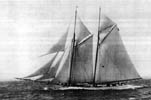 |
Coronet under sail |
During the crossing Alden Day, ships cook and native of Boothbay, Maine died. In July, while off Cuba, 2 year old Jabez Sellick died. Later that month, they cruised off the coast of Virginia, where Capt. Perry, Capt. Lester McKenzie, Roland Whittom and Bertram Dustin went ashore in the launch for supplies. Capt. Perry went on to New York and acquired the brig Barracouta with money provided by a British Kingdom member, Helena Mary Newton, ostensibly to remove passengers from the Coronet and to sail them to Portland. Meanwhile back off the Chesapeake and fully provisioned, the launch with McKenzie, Whittom and Dustin failed to rendezvous with Coronet off the Virginia Capes. The three therefore sailed and motored the launch all the way north to Boston. Perry, having as much luck as did the launch, also failed to track Coronet down with Barracouta. Coronet was by this time on its way to Greenland to ostensibly complete Mr. Sandford's commission from God, continuing on in an overcrowded and by this time, badly leaking hull to the north.
In August, Benjamin Cook died on board. Responding to an article in DownEast magazine regarding Arnold White's book The Almighty and Us, in 1974 Frank Murray wrote that Day and Cook died of "natural causes", and intimated Sandford should not have been held responsible for their passing.
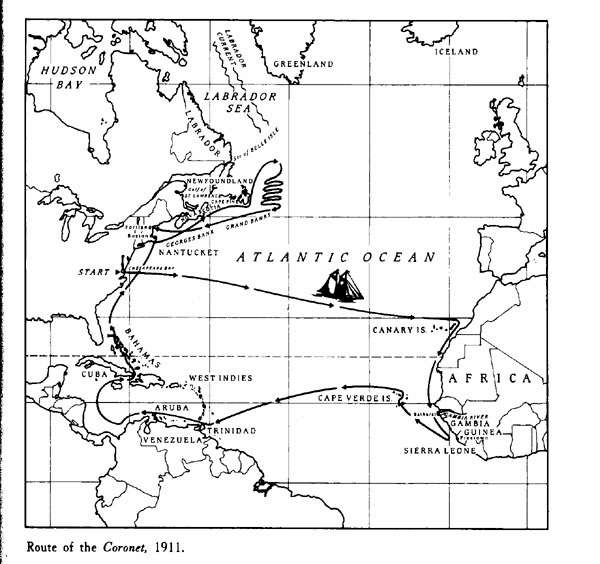
There are several versions of just what made them finally turn around. It depends on what source one is referring for the explanation, but suffice it to say that on September 6, 1911 Sandford finally and reluctantly put about to head for home. This was five months lacking six days from the abandonment of the Kingdom in West African waters. At Sandford's trial, Roland Day and John Bolster cited lack of food, tattered sails, a leaking hull, and the leaving of normal shipping channels (their only source of supplies) for the arctic as reasons for turning back. Others on board also felt in unity with Day and Bolster. Mr. Sandford ultimately agreed to turn back, but warned of God's wrath because of it.
On September 28, George Hughey died of scurvy. On October 16, Charles Hughey and Ralph Merrill died of scurvy. On October 17, Stuart Wolfe, a former student at the Boston University School of Medicine died of scurvy. On October 21, 1911, the Coronet arrived in Portland. Few ships arrival in Portland harbor have caused as much stir in the twentieth century. It was, as many described it, a ghost ship. Battered, tattered sails, a severely leaking hull, several of her passengers were removed to local hospitals for care and observation. John Bolster and John Adamson died days later in the Portland Marine Hospital shortly after landing, making a total of six men who succumbed to the ravages of mal-nourishment and scurvy.
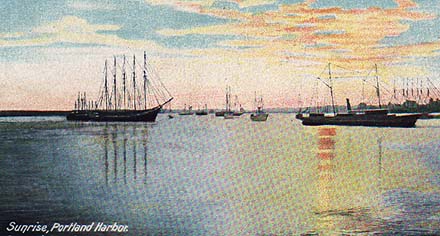 |
Sunrise in Portland Harbor, circa 1910, from an antique postcard |
Mrs. Whitaker's warrant was served and Mr. Sandford spent the evening in jail. Samuel Sylvester, an atheist admirer, and William Wakeman posted the $10,000 bond at 11:00 p.m. (The Whitaker case, however, was not tried until 1912, with Sandford in absentia). On October 26, a federal arrest warrant for manslaughter was executed on Mr. Sandford. He was tried (without counsel), convicted, and sentenced on December 18, 1910 to the Atlanta Federal Penitentiary.
Excerpts form John Adamson's diary are posted on a different web page herein. John, 19 years old and a student at Shiloh, was made second mate aboard the Coronet on the return trip from Africa. A Sandford stalwart to the end, his diary reveals the mundane chores of a seaman "before the mast", as well as a few eye opening observations.
OPINION - Unanswered Questions
Why didn't they put into shore months earlier? Why with schemes and plans only Rube Goldberg could have endorsed would they plan to re-provision the Coronet miles at sea. Wouldn't wisdom dictate putting into port, letting the surplus passengers off, and then re-stock the Coronet's galley and water tanks? The story told in Kingdom circles for years and that Murray endorses in Sublimity of Faith was simply that God didn't tell them to do so. The Kingdom faithful evidently are willing to accept this dodge. They also believe Mr. Sandford was responsible to no one but God. Murray, in an effort to minimize the rationale of running from the long arm of the law, refers in his letter to DownEast that they did in fact put in at San Salvadore coming west, which "blows a hole in that theory". That may be, if San Salvadore were the only port between the Carribbean and Portland. It was not.
In Sublimity of Faith, Murray makes it known that Sandford left Casco Bay either during or immediately after the Mrs. Whitaker debacle, using the scripture of "dusting off one's feet and heading for the next town" as a justification not to stick around while Mrs. Whitaker sought legal action. By acknowledging the legal action Mrs. Whitaker was about to pursue, it is at best difficult if not impossible for Murray or any other Kingdom stalwart to minimize and play down the motivation for Sandford to stay off shore during the next 15 months.
Arnold White, in his book The Almighty and Us, tells of an incident on the way east as they sailed up the Potomac to pray for President Taft and the country. While Coronet lay at anchor, a contingent from the Coronet were sent ashore in the launch, where communiques were sent to Shiloh, and provisions were purchased. In so doing, White posted a letter to an uncle living in Virginia, and made the mistake of including a return address of the particular post office from whence he sent it. When on a subsequent trip ashore White found a return letter from his uncle, it was made known to Mr. Sandford that their whereabouts had been compromised. Arnold White was shunned by the ship's crew for about a week, and ultimately put ashore and sent home to Maine.
As mentioned earlier, in December of 1910 Pat O'Connor and Alexander Sinclair drown in an incident involving the launch and the lack of a pocket knife. In dismissing this story as an unfortunate accident, Kingdom lore has, once more, attempted to portray a somewhat prettier picture than the facts reveal. The two individuals involved were anchored in a small launch off shore in an inlet of Chesapeake Bay, waiting for a landing party to return. They had not allowed enough line on the bow anchor for tidal fluctuation. As the tide started to come in and the wind and waves began to pick up, they soon found water coming in over the bow, swamping the boat. One could swim, one could not, and in a heroic effort to save the non-swimmer, both perished. Kingdom lore tells the story that had the two men possessed knives, they could have easily cut the anchor and not swamped. The positive spin placed on the story is that Mr. Sandford then commissioned the ships carpenter to fashion knives for all the crew to carry at all times. What the Kingdom historians have failed to mention through all the re-tellings of this tale, is that had O'Connor and Sinclair been waiting on the beach, and not off shore, none of this would have happened. Better yet, had the leader of the expedition not been avoiding the law so scrupulously, orders to stay anchored off shore to avoid contact with others would not have been given, and Coronet could have put in to any number of ports while re-provisioning was being undertaken.
If it really had been God's will to establish an African mission in the spring of 1911, why had there been an outbreak of small-pox upon their arrival at Bathurst, preventing them from disembarking? Did God change his mind? Murray explains in his letter to Downeast how the group labored fastidiously to discern the will of God before leaving African waters. Couldn't they have off-loaded their extra complement of passengers more readily in Liverpool at Pas-dammim (the Kingdom's former center in England) or perhaps even some other needy mission field rather than make for Greenland by way of the Carribbean? Arnold White indicates that a discussion took place dealing with the possibility of temporarily leaving volunteers at the American consulate in Africa, but the option was vetoed by Sandford. Murray also indicates that Sandford's chief reason for leaving Casco Bay and putting to sea back in June of 1910 was to establish the Greenland connection. If that was truly God's will in the first place, why then was that not done in September 1910 when the Coronet was cruising in the Gulf of St. Lawrence? Somehow, they saw fit to turn south and make for the Chesapeake, and then the Carribbean, then the Canaries, and finally Africa (loosing the Kingdom in the process), not bother with Africa, return to western hemisphere via South America, turn northward through the Carribbean, put in at Haiti during the middle of a civil war, put in at San Salvador, cruise in circles miles off the Virginia Capes, sending 4 men ashore with a launch to shuttle supplies back out to sea, miss that connection, ultimately miss a second possible connection with the newly acquired Barracouta, and end up 800 miles south of Greenland in September 1911 before turning around to head home in a boat filling with water as fast as they could pump with a crew in the various stages of succombing to scurvy. We were taught that things STARTED to go wrong when they disobeyed God's will and turned around to head home. But it seems now that somebody left out a lot of the story in the re-telling. All the twists and turns of the plot are ultimately somehow explained or excused by wrapping the whole event up in a neat little box and labelling it "God's will".
Again, in Murray's letter to
Downeast magazine, he refers to a little known detail of a businessman on his own
power yacht approaching the rag-tag Coronet off Cape Elizabeth as she was
returning to Portland from the north. The businessman offered to take Mr. Sandford
off Coronet and ferry him to Canada to, as Murray puts it, escape the
"harpies of the press". Now it may be that there were no newspapers or
associated reporters in Canada at the time, but could it be that the major thrust in
discussing a Canadian port of call might have been the lack of U.S. authorities north of
the border? One can only speculate at the businessman's motivation for offering such
a cruise, especially to one who had just returned from across the Gulf of Maine. Mr.
Sandford declined the offer, and said he would face whatever God had in store. All my life the Kingdom glorified the Coronet and all
she "stood for". Victory, purity, holiness, and other such spiritual
abstractions or adjectives used in reference an individual's spiritual condition
were instead attributed to a 110 year old wooden boat in a steadily deteriorating
condition. During the years since Mr. Sandford's death, we believed that the Kingdom
leadership felt this way, because, in large part, we thought Mr. Sandford felt that
way. It is interesting to note that subsequent to Mr. Sandford's incarceration
during the thirty years between 1918 and his death in 1948, there is no record of his ever
setting foot on the boat again. In fact, it has been pointed out that Mr. Sandford
had serious reservations about undertaking the restoration of the boat in the mid
1940s. During my lifetime, it was clearly certain influential church leaders who
promoted the boat's supposed spiritual attributes, and saw to it that funds be made
available for it's continued upkeep. Today, the yachting community may clearly owe
the Kingdom and those who volunteered to sacrifice themselves and families as boat-keepers
a debt of gratitude, but the focus of my criticism goes straight to the heart, soul,
definition and responsibility of what a church is supposed to be.
It didn't matter that Sandford died in 1948 without fulfilling any of his own
prophecies. It didn't matter that, during the 1980's, it took upwards of $20
thousand dollars a year of church resources to maintain Coronet and keep her
afloat. The resources drained away from the church's general fund to keep leaders
with a love for the salt air spiritually jazzed was tantamount to what might be construed
in any other venue as, at worst, embezzlement and at best a misappropriation of
funds. Too expensive to fix properly, too "holy" to sell to just
"anybody", and too deteriorated to use as she had been designed to be used, she
become a church "asset" without quantifiable benefit or function. Those
who lived aboard and sacrificed much to keep her going during those years have stated
that, to the end, she inspired and instilled in them, among other things, the Sandfordian
spirit of "never-say-die". That's all well and good if you're Newt
Rockney, and Lord knows every church needs some "team spirit". But
inducing and maintaning a spiritual buzz was never the defining mission of a healthy
church community. The sorrow, shame and sacrifice of the Coronet's northern voyage
was never mentioned nor discussed openly or honestly in Kingdom annals or services.
It is a travesty to the memory of all who lived and died through that ordeal to
perpetrate the history that God was somehow punishing them for their unfaithfulness to
Him. As with the media pundits of today, I guess to rewrite history all one has to do is
spin the story to your advantage and keep the masses in the dark as to the full scope of
the text; just keep telling the story your way enough times and people will believe it as
fact. For many, in both my and my parent's generation, it almost worked. But in
searching out the rest of the story, it has become abundantly clear to me that what the
Kingdom leadership taught and demonstrated through its actions and deeds was that
Sandford's legacy and image mattered more. The real agenda has always been and still
remains Mr. Sandford and his legacy. It just matters more. More than
families, more than people, more than honesty, more than souls.
Reginald Parker, Ed.
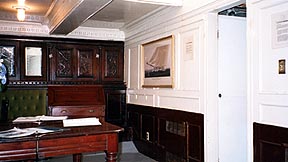 |
 |
 |
| in the saloon, Sept., 2000 | from the bow, Sept., 2000 | from the stern, Sept. 2000 |
Sept. 2000 photography courtesy of JDS